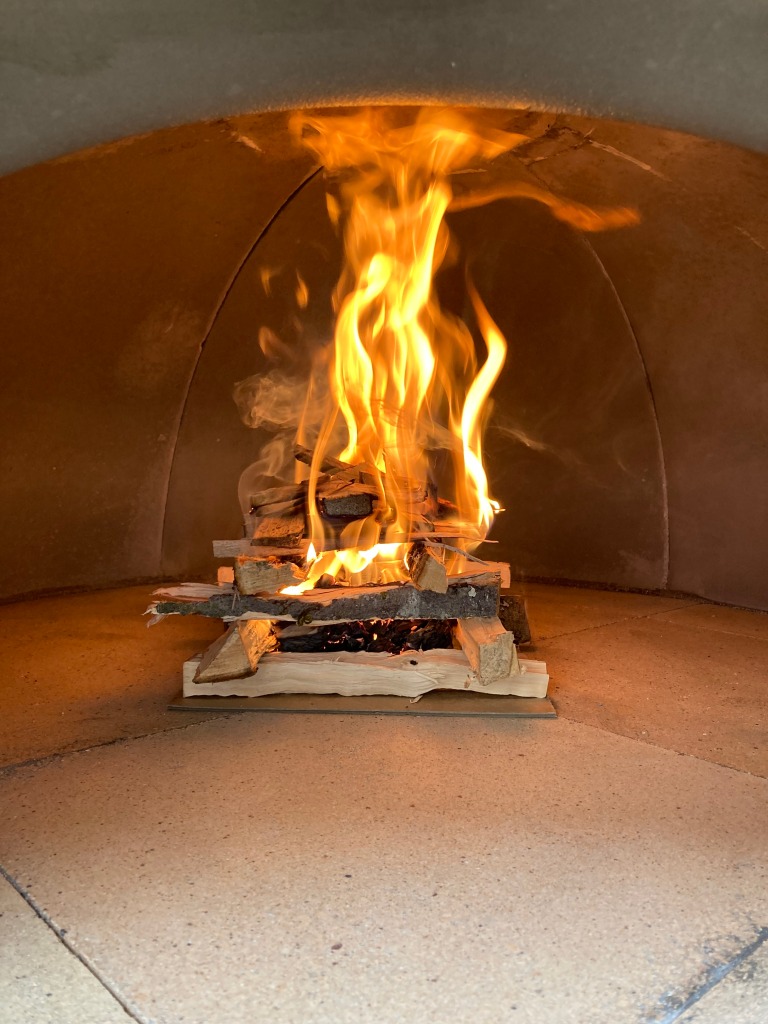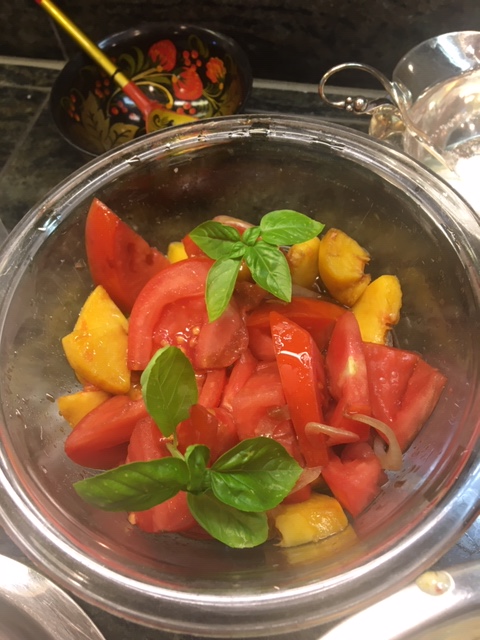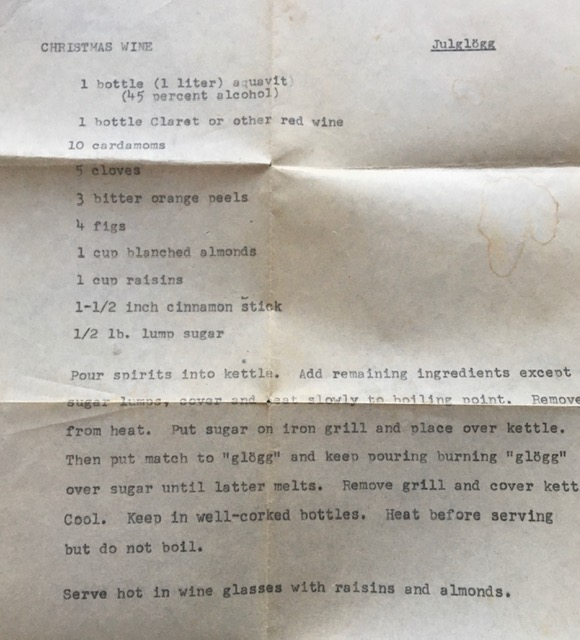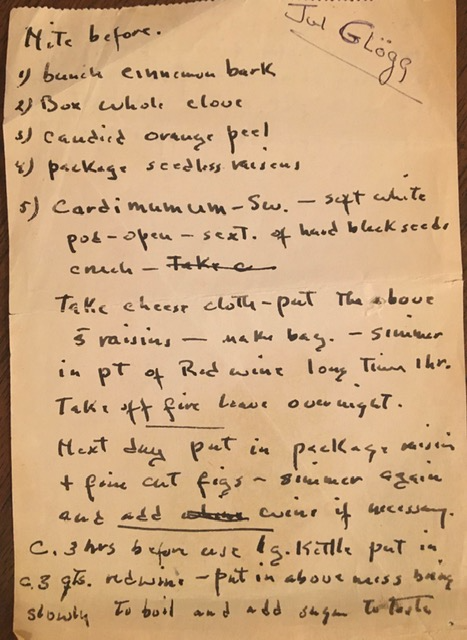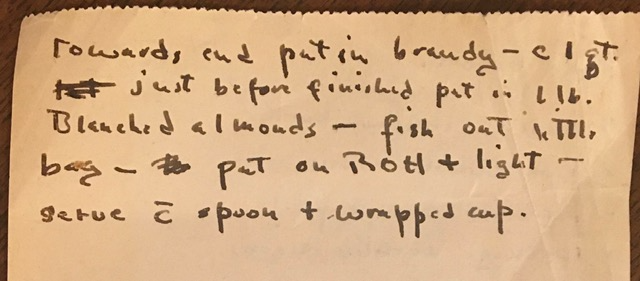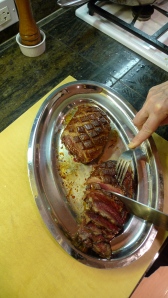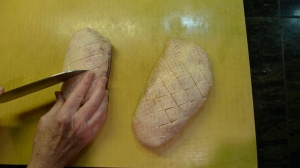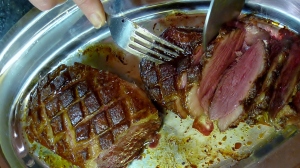
Jim’s atelier, photo by Annabelle Adie
I have been asked how exactly I go about cooking a meal for 100 people.
First, the back-story. About 10 years ago, my husband and I had moved to Paris for what we thought was one year. Within a few weeks of our arrival, our friend, Philippe Gérardin, told us about an American who for over thirty years has given dinners at his atelier in Montparnasse on Sunday nights. Guests make a reservation and pay a donation toward expenses. Oh, and the cooks are volunteers.
“Go to one of Jim’s dinners. You’ll meet all kinds of interesting people,” he promised and gave us Jim’s phone number. We were intrigued.
“Jim Haynes here.” A brisk voice answered my call. “Do you want to come to next Sunday’s dinner? Where are you coming from?” He rattled off his address, metro stop, and the door code. He asked for our names and said, “You’re on the list. Show up at 8:00.” That was it.
Every Sunday night in Paris, except during the month of August, Jim Haynes opens his doors to a throng of folks some of whom he has met and many he has never laid eyes on.
How many guests? Rarely less than 70 and in good weather, topping 100.
Behind the facade of many Paris apartment buildings, there exist rows of ateliers where artists and craftsmen have lived and worked for generations. Jim’s atelier, overlooking a garden path, is one of these. The party was in full swing when we arrived with guests standing in the garden and pouring out the doors. We made our way inside to find a tall, genial American seated on a stool with clipboard in hand. “Mary, Paul! Welcome! Meet Stephan and Natalie and Lisa!” We were checked off the list, pointed to the bar (outside in the garden) and introduced to at least ten other guests of various nationalities. One of Jim’s best-known characteristics is his ability to remember names. If he’s met you, he remembers you.

Jim at his party, photo by Paul Allman
We were handed a bowl of soup and instructed to line up for the next course when we were ready. Some guests were already digging into plates of stew with rice and salad.
That first dinner was a blur of faces, names, and a three-course meal eaten standing up. We came away slightly dazed but feeling we had participated in an international happening that was purely positive. Throughout, Jim’s voice introducing people and exhorting them to “Talk!” was funny and contagious. We met several people that very evening who became friends.
We also got to know Jim. The short version of his incredible life is that he arrived in Europe from Louisiana with the Air Force in the late 1950s and never went back. Between then and now, he has done remarkable things, including founding the Traverse Theater in Edinburgh, writing a lot of books, and a thirty year stint as a university professor in Paris. He hasn’t missed a Frankfurt Book Fair for 50 years and is a beloved fixture at various film and book festivals worldwide. However, he has become best known for having the longest running dinner party ever.
How the dinners started is essentially a tale of a good party that kept getting bigger. Back in 1978, Catherine Monnet, a young ballet dancer from Los Angeles, needed a place to stay and through a friend, found her way to Jim Haynes. To repay his hospitality, Catherine offered to cook dinners for his friends. At first, the dinners were small but over time, they grew so large that guests began to contribute toward the food costs. Catherine eventually found a place of her own but continued to cook at Jim’s from time to time and does so to this day.
News of the dinners travels by word of mouth and they are famous for the start of friendships, love affairs, and marriages. People have found places to stay, new jobs, and opportunities for travel by participating in a Sunday dinner. Today, Americans and Parisians represent about half the crowd and an international mix make up the rest. Sometimes, you can hear six languages spoken at once.
What I’ve noticed over the past ten years is that the makeup of dinners goes through periods of change. If there has been a recent article or a You Tube video about Jim, there is often an influx of travelers and students, particularly Americans. People book by e-mail rather than the telephone. For the ‘regulars’, Parisians for whom Sunday night means going to Jim’s, this can be disconcerting. But most are philosophical and are glad that the dinners continue to grow and remain vibrant.
After our dining experience, I was curious about the cooking. I found out that the volunteer cooks at Jim’s are visitors, houseguests, and occasionally, chefs and cooking students. Jim was enthusiastic when I offered to cook and I was delighted to find no shortage of helpers when I took on the task.
Shopping in such quantity is a challenge especially without a car. Jim, who has never owned a car, thinks nothing of taking the metro to Frères Tang, a giant Chinese grocery, and returning with 35 pounds of chicken in his shopping cart. Grateful to their loyal customer, Eric and Alice, who run the neighborhood vegetable stand, make sure the thirty avocados or fifty melons are perfectly ripe come Sunday evening. Shopping with Jim, I became familiar with the local merchants who offered discounts and deliveries. Through Catherine Monnet, I discovered the North African and Indian markets of Paris where bargains such as whole trays of baked pastries and 20-pound bags of rice can be bought for a song.
Different parts of Paris were opened up for me. I loved finding out about the markets, the butchers, and the neighborhoods. I was hooked.
I now cook at Jim’s about 8 or 10 times a year.
So, here’s my approach:
The Menu
On Wednesday or Thursday, I write up a menu and a shopping list and e-mail it to Jim. I plan for either 80 servings or 100 servings depending on the weather. If it’s dry and not too cold, the guest list is long because guests congregate outside in the garden area. On a rainy February evening with everyone squeezed inside, Jim keeps the list to about 65 or 70 people although he has a terrible time saying no.
For a crowd mostly standing up, the food has to be eaten easily with only a fork and/or a spoon. For the first course, soups (hot or cold), composed salads, a slice of quiche, a turnover, an empanada, or bruscetta works well. For the main course during winter months, we serve stews of all varieties and baked pasta dishes. Indian foods, which can be served room temperature, are excellent in any season. Thai curries and salads are also much appreciated and especially good in warm months. For dessert, it can be as simple as ice cream with chocolate or caramel sauce and a cookie. We make a lot of crumbles and crisps with fall fruits. Cakes and pies are more ambitious and time-consuming but definitely a crowd pleaser.
For vegetarians, there is always an alternative to meat.
Examples of menus:
A spring menu
Indian Ginger Pea Soup
Blanquette De Veau (Veal Stew)
New Potatoes
Strawberries in Balsamic Vinegar
Pine Nut Cookies
A summer menu
Green Mango Salad
Chicken in Thai Green Curry with Rice
Pineapple Ice Cream Sundae with Caramel Sauce
A fall menu
Tomato and Fennel Soup
Le Puy Lentils and Sausages
With Onions and Peppers
Apple Brown Betty
A winter menu
Blue Cheese, Endive, and Walnut Salad
Beef Bourguignon with noodles
Spinach
Cherry Chocolate Brownies
Chile dinners with cornbread and guacamole are very popular. Also, cozy foods like potato salad, meat loaf, macaroni and cheese, lasagna, and mashed potatoes. These things make the old ex-pats nostalgic and the newcomers a little homesick. And it all adds to the conversation.
I’ve had some fun surprises. One weekend, I mentioned to my friend Trish Nickell that I was planning a Tex-Mex meal and wondered what to have for dessert. “In Dallas, if we go out to eat, we always finish up with a praline.” Oh really, I thought.
Seeking to be authentic, I decided I’d just ask one of those Dallas restaurants for their recipe. I called El Fenix, explaining I needed to make about 200 pralines for next week’s Sunday dinner in Paris. “We can’t give you the recipe,” the manager explained, “But we’ll send them to you.”
And that’s exactly what happened. A couple of days later, a big box of wrapped pralines arrived. At no charge. The crowd went wild.
Quantities
Figuring out how much to buy takes a little practice and having done some catering helped me. My method is both micro and macro. First, I think about an individual serving. Meat and fish will probably be the costliest part of the menu. A 5-ounce portion is not lavish and I usually add a few pounds for good measure. I like to picture what the plate will look like with the vegetables and potatoes (or rice or pasta).This helps me to balance the meal and control the costs by not over ordering.
Here’s a little table:
25 servings 100 servings
Soup:
(1 cup/serving) 7 qts 25 qts
Main course
(5 oz/serving) 8 lbs 32 lbs
Vegetables:
3 oz/serving) 6 lbs 22 lbs
Salad greens
(2 oz/serving) 3 lbs 13 lbs
(This may not seems like much but remember lettuce is light in weight but long in volume.)
When you have a party for less than ten people, you need to cook more than enough in order to make the platter or the salad bowl look plentiful and appetizing. If your guests are sitting around the dinner table, eating leisurely, having seconds or even thirds should be expected. For a huge crowd, you can be a bit more calculating. Put another way, a handful of guests may only eat a small plate of salad but counting out the exact number of cupfuls might make for a miserable and stingy looking bowl of salad. Having leftovers from a small party is great. But enormous quantities of leftover food are not only wasteful and expensive but a lot more work to prepare and store.
Another way I figure out quantities is by a simple head count. For example, if I’m serving fresh cantaloupe, I calculate the serving size. A quarter each? I’ll order 25 melons for 100 servings, usually adding a couple of extras to be safe. For Puffy Baked Potatoes (see recipe below), I count on ½ baking potato/person. From experience, I know that there are about 4 servings of asparagus in a pound, that a 4-pound cabbage makes a hell of a lot of slaw (at least 4 quarts.)
Oh, and don’t try to make freshly cooked spinach for 100 people unless you have a convenient warehouse next door. Use frozen, please.
Ordering
For Jim’s dinner, I telephone or visit Eric and Alice with the vegetable order on Wednesday or Thursday. We talk about what is in season and if I’ve chosen something that’s too hard to get, too expensive or out of season, Eric always lets me know and makes suggestions. At the local Boucherie Chevy, a small chain butcher shop, Monsieur Dominique is as meticulous as Eric is. After touching elbows (M. Dominique doesn’t shake hands on the job), we usually talk about the menu and he suggests how best to prepare the meat. Twelve kilos (about 25 pounds) is the usual quantity. For some stews, he will cut the meat in cubes. Beef to be ground is not prepared more than an hour before purchasing. Roasts are beautifully tied, chickens are boned and often, he throws in bones and ‘les abats’ for making stock.
On Friday, Jim or one of his houseguests picks up the items from Franprix, the local grocery store: cheese, milk, butter, and eggs as well as rice or pasta, canned goods and so on. Eric delivers the vegetables on Saturday morning. He will also deliver on Sunday morning as well which is a huge convenience when it comes to storage.
We also use Picard: a store entirely devoted to frozen foods of excellent quality. For fish, Picard is a good economical choice, given the large quantity purchased.
How can this translate to a large party at your house? Buying a lot of food means you have to store it somehow. Any approach you can take to delay the arrival of food helps. You might do exactly as I’ve described above: go to your local supermarket, small grocer, farmer’s market or wherever you shop and ‘order’. Tell them what you need and when you need it. You may not have delivery service but you can arrange to pick it up close to when you need to deal with it. If you’ve ever tried navigating your way through a kitchen full of pineapples or a refrigerator bursting with lettuce, you’ll see the wisdom of letting others stash your produce.
There is a case to be made for shopping, storing, and cooking in advance. And if you have lots of refrigerator and freezer space and like to string out a project over time, I can see the benefits. But personally? I like the freshness of produce and also, the immediacy – well, let’s call it the pressure – of cooking it all and serving it all in the same weekend. It’s like a sporting event: you’re on and then it’s over.
Cooking
I start the cooking on Saturday around 1:00. I make a list of all the jobs or prep work and then divvy up the tasks. Often my friend Leslie Diamond comes over to help and usually, any houseguests staying at Jim’s will volunteer as well. More often than not, Madame Paupert, Jim’s upstairs neighbor stops by, and makes short work of any peeling job.

Madame Fauvette Paupert, photo by Philippe Gerardin
We bake on Saturday, prep for the main course or salad, and often make soup which is cooled down and refrigerated overnight. We’re generally through by about 5:00.
On Sunday, same hours: I make the vegetables and main course and then leave a list of last minute chores before going home to get cleaned up and relax a bit before the dinner.
Most of the menu can be cooked at least a few hours before serving but I’ve learned some tricks. Fresh vegetables like broccoli suffer if overheated; green beans and fresh herbs will turn a horrible olive color if allowed to sit in vinaigrette for too long. Soups, cooked beans, lentils, and grains can scorch and stick to the bottom of large heavy pans when the heat is on for a long time. So what to do?
Keep food hot using a bain marie or water bath. Be sure to heat the food first and then set the pot into a larger pot with simmering water. Keep the heat low and check the water level from time to time.
Mashed potatoes stay nice and hot in a water bath but do not cover them. They will develop an off taste. Potatoes continue to absorb liquid over time so mash the potatoes with plenty of liquid so they don’t become too stiff.
To avoid mass of wilted greens, don’t dress a salad until serving time. With a large quantity of lettuce, divide it among 2 or 3 large bowls and keep chilled. Dress each bowl as needed.
Serving
Seamus McSwiney is a long time friend of Jim’s and a master of serving a hot meal to a hungry crowd. Over the years, he has perfected a system that is really efficient. Working on his own, he serves the three-course meal in overlapping stages. He puts out about 10 to 15 servings of the first course (usually a salad or soup), replenishing as diners line up to help themselves. For the main course, Seamus serves directly from the pots, setting out the plates whilst catering to those who want smaller portions, a vegetarian meal, or have other considerations. He arrives at Jim’s about an hour before the party to set up, makes rice if necessary, reheats the main course, and directs helpers to slice bread or toss the salad. Jim and his houseguests generally set up the bar outside in the garden and put out chairs.

Seamus slinging hash, photo by Paul Allman
How do the plates look when they’re served? Not like in a restaurant, that’s for sure. The food can be delicious but it won’t be ‘presented’. And as a cautionary note, I would add that the aim is provide a good meal that’s plentiful, tasty and the right temperature. Sprinkling garnishes, drizzling sauces, or supplying any other such niceties can really slow down the serving process. Simple is better.
I repeat dishes that work well, taste good, and seem to be popular. So I’ve got the timing down pretty well. However, there are times when I’ve found myself in the weeds and have to cook down to the wire.
New cooks to Jim’s discover quickly some pitfalls of an overly ambitious menu – but even then, it can be fun and a learning experience as you scramble around trying to finish up by 8 pm! My young cousin (and now Cordon Bleu student) Kate Atkinson once cooked a Mexican dinner with Michael Boone. “We even made sopapillas from scratch! It was crazy!” Michael, who is pursuing a career as symphony conductor, is an enthusiastic Sunday night dinner cook, channeling favorite recipes from his Indiana grandmother.
I have certainly been overly ambitious. A fall menu with a beet salad, cabbage rolls with ground veal in Riesling, and an apple and quince crumble was hugely time-consuming. Thank heavens Madame Paupert was there, stuffing 200 cabbage leaves without a complaint. On another occasion, the ‘Croustillant aux Asperges’ was a nightmare for serving: involving as it did Hollandaise, puff pastry, and all that asparagus. Jim loves apple desserts and bought a gizmo that peels, cores and slices apples. But as our friend and frequent Sunday night cook Antonia points out, if you have 150 apples, it still takes time.
I tend to use raw materials, peeling and chopping just about everything. Jim thinks this is ridiculous and points out the benefits of large bags of frozen chopped onions, garlic, and peppers. He’s right, of course: for a large crowd, using these products certainly makes sense. But, what the hell. I do it because I enjoy it. And it’s more than just the cooking. I’ve met more interesting and unusual people around his kitchen table than I ever would have imagined. Swapping stories while peeling apples is a great way to spend an afternoon. My circle of friends in Paris has widened and grown younger and I am very grateful.
It’s been a lot of fun meeting other cooks. About two years ago in Portland, Oregon, I was at a cooking class and met Jackie Thau, an enthusiastic cook (and also charge nurse in an OR). We got to talking about Jim’s dinners and she decided to sign on to cook. She ended up coming to Paris with friends and family and cooking a fabulous meal. Professional pastry chef David Gauchat of Cleveland cooks for Jim on his visits to Paris (and taught me how to make Goop.) Galena Prokhor, an émigré to Paris from Russia, is nearly a genius with her soups, stews, and cakes and somehow, makes it all look so easy. Jodi Poretto, from New Orleans, always makes red beans and rice on her trips to Paris. Two new friends of mine: Amanda Morrow and Miranda Crispin got their feet wet, so to speak, cooking chez Jim and have started an underground Paris touring company with a dinner club. One Sunday, my friend, Jorge Pagliarini, an extraordinary cook, thought nothing of making over 200 macarons for dessert. Guests nearly fainted with pleasure.
Are you game? I’ll include some recipes.
RECIPES
The following recipes are for 25 servings. Keep in mind ‘servings’ are not ‘guests’. If you are planning a party for 12 good eaters, you should make the entire recipe. Ditto for 5 teenage boys.
TOMATO AND FENNEL SOUP
This is a tomato soup that I really love and always gets raves. The fennel flavor is boosted with the tarragon and Pernod. An immersion blender is useful for this soup.
- ½ cup (4 ounces) butter or olive oil
- 1 pound onions, chopped
- ½ pound carrots, chopped
- 1 ½ pounds fennel, chopped
- ¾ cup Pernod or Herbsaint or other anise liquor
- 3 (29-ounce) cans of tomatoes
- 1 quart chicken or vegetable stock
- 5 sprigs fresh tarragon
- 5 sprigs fresh parsley
- 2 cups heavy cream (substituting milk is okay)
- Salt and pepper
Melt the butter or olive oil in a large pot and slowly sauté the chopped onions, carrots, and fennel about 10 minutes or until soft (but not browned.) Stir in the tomatoes and continue to simmer a few minutes. Add 3 cups of stock and the tarragon and parsley. Simmer over low heat for 30 minutes. Remove the herb sprigs and add Pernod.
Puree the soup using an immersion blender. Or working in batches, use a blender or food processor. Return the soup to the pot and bring to a simmer. Add the cream. If the soup is too thick, thin it with more stock. Season with salt and pepper.
GREEN MANGO SALAD
This salad makes a delightful appetizer or side dish with a spicy curry or with grilled fish or chicken. The job of grating the mangoes can be speeded up if you have a food processor. The ingredients can be prepared in the morning and put together at serving time.
For 25 servings
- 4 large firm mangoes
- 1 cup unsweetened coconut
- 2 ½ pounds bean sprouts
- 1 bunch basil
- 2 bunches scallions
- ½ cup fish sauce
- ½ cup lime juice
- 4 tablespoons brown sugar
- 1–2 tablespoons chile garlic sauce
Toast the coconut in a dry frying pan, taking care as it burns easily. Let cool and set aside.
Peel the mangos and grate or julienne finely. Refrigerate covered. Rinse the bean sprouts quickly in water, drain, and refrigerate.
Mix the fish sauce, lime juice, sugar, and chili sauce for the dressing and set aside.
To serve, combine the mango with the basil, scallions, bean sprouts, coconut, and the dressing, mixing gently.
JACKIE THAU’S ROASTED GRAPES
This is a great appetizer for large scale cooking: it involves very little preparation and can be eaten with the fingers. In Jackie’s words, “Hot, cold, next day – all good. I like mixing the colors and using black sea salt when they are done.”
For 25 servings
- About 9 pounds or 5 bunches of grapes, different types (and colors)
- Olive oil
- 3 or 4 sprigs rosemary
- 3 or 4 cloves garlic, peeled and halved
- Salt
- Black sea salt (optional)
Snip the grapes into small clusters and arrange on a sheet tray. Drizzle with olive oil, sprinkle a little salt, and strew the rosemary sprigs along with the garlic over the grapes. Roast at 350 for about 5-8 minutes until they are hot. Pull from the oven and give them a little dusting of salt and serve.
SABZ GHOST (LAMB IN COCONUT MILK)
Antonia Hoogewerf’s Indian dinners are among the most popular at Jim’s Sunday night soirées. Sabz ghost, a famous and deceptively simple Indian dish, is exotically spiced yet mild and creamy. Check the seasoning during the cooking time. Peppers will continue to get hotter the longer they cook.
For 25 servings
- 8 pounds lamb, cubed
- ½ cup garlic, finely minced
- 1 (5-inch) piece ginger, peeled and finely chopped
- ½ cup cooking oil
- 1 ½ cups whole blanched almonds
- 1 cup raisins
- 6 cardamom pods
- 6 whole cloves
- Salt and pepper
- 1 cup plain yogurt
- 1 green chile pepper
- 1 dried red pepper
- 2 cans coconut milk, unsweetened (more may be needed)
- 1 bunch cilantro, chopped
Marinate the lamb in a large bowl with the garlic and ginger for 2 hours. In a large pot, heat the oil and fry the almonds and raisins for a few minutes or until they are lightly browned. Set aside. Using the same oil, add the cardamom, cloves, and the lamb and brown, stirring, over high heat
Mix in salt, pepper, and yogurt. Lower the heat and cook until the yogurt is completely absorbed (about 30 minutes). Stir in the red and green chili peppers and half of the chopped cilantro. Add coconut milk and cook over low heat, stirring regularly, for about 40 minutes to an hour. When the lamb is tender, add the almonds and raisins. Cover the pan and simmer until the sauce is reduced.
Taste for seasoning, adding additional coconut milk if too spicy. Garnish with the remaining chopped cilantro and serve hot, with chutney, Naan bread, and rice.
PUFFY POTATOES
They don’t always puff but mostly, they do. This is a baked potato for one person or a horde: incredibly easy to prepare and tasty as is, although you can certainly pass the butter. Potatoes are best eaten once cooked so they cannot be baked too far in advance. Be sure to select baking potatoes that are not too large, keep the heat high, and do not skimp on the coarse salt.
For 25 servings
- 14 baking potatoes, medium-sized
- Coarse salt
Preheat the oven to 450 F. Scrub the potatoes and cut in halves lengthwise. Arrange the halves, cut side up, on a baking sheet. One baking sheet will fit about 25 halves.
Sprinkle generously with coarse salt. Bake for 40 minutes or until the tops are browned and puffed.
Test by plunging a knife through the center of one to determine doneness. Serve within the hour.
They may stay in a turned-off warm oven but do not cover them.
PINEAPPLE SUNDAE WITH CARAMEL SAUCE AND ICE CREAM
The caramel sauce can be the starting point for all kinds of ice cream desserts or served with cake or bread puddings. It can be made days in advance and even frozen for longer storage. Making caramel can be tricky: if one sugar crystal bounces out on the side of the pan, the whole thing can seize up and crystallize. To avoid this unhappy situation, my friend and former chef Susan Lindeborg proposes the method described below.
For 25 servings
- 2 cups sugar
- ½ cup water
- 1 pound butter
- 1 cup crème fraîche or heavy cream
- 1 teaspoon salt*
- 4 ripe pineapples
- 3 quarts vanilla ice cream
Mix the sugar and water together and pour carefully into the middle of a large pot. Melt the sugar without stirring until it bubbles around the edges. Cover the pot with a tight lid as the mixture approaches a boil. When the caramel is a dark golden brown, add the butter, cut in pieces, but do not stir. When the butter starts to melt, stir gently until the mixture is a homogenous mass. Cool a few minutes and add the cream and salt. Serve warm or cold.
Peel the pineapples, remove the tough inner core, and cut into cubes. Cover and refrigerate until serving time.
To serve, top a scoop of vanilla ice cream with a spoonful of pineapple and some of the caramel sauce.
*Kosher salt, sea salt or fleur de sel are recommended.
PINE NUT COOKIES
These are elegant little cookies: crisp, buttery, and not too sweet. This recipe serves at least three average size cookies per person. Using parchment or baking paper is highly recommended, as the cookies are fragile when hot. Quickly lifting the entire sheet off the baking tray eliminates using a spatula to transfer each cookie.
For 25 servings (7 dozen)
- ½ pound butter, softened
- 1 ¼ cups powdered sugar
- 4 Tablespoons sugar
- 1 teaspoon vanilla
- 1 ½ cups flour
- 1 teaspoon salt
- ½ teaspoon (scant) baking powder
- 6 ounces pine nuts
Beat together the butter and sugars. Add vanilla. In a separate bowl, mix the flour, salt, and baking powder.
Toast the pine nuts lightly in a dry frying pan either over medium heat or in the microwave. Watch carefully as they burn easily. Let cool. Grind half the pine nuts in a food processor or blender.
Add flour mixture and all the nuts to the butter and sugar mixture. Drop by rounded teaspoons, 2 inches apart (these cookies spread) onto baking sheets lined with parchment paper. Bake in a moderately hot oven (325 F) 8 to 10 minutes or until set and brown on the edges. Carefully transfer to racks to cool completely.
This cookie dough may be made in advance and refrigerated a few days or frozen. Once baked, the cookies will keep very well in tightly sealed bags or boxes for 2 weeks.
GOOP
Nothing sticks when Cleveland pastry chef David Gauchat’s mixture is brushed on a pan.Use it for cakes, fruit desserts, baked pasta and meat dishes. And it lasts forever.
The non-stick formula (which David lovingly calls “Goop”) is simple: one part vegetable oil, one part flour and one part Crisco all whipped up together, put in a container, and left in the cupboard. Voila!
SOME FINAL NOTES:

Jim’s party, photo by Annabelle Adie
If you find yourself in Paris and want to join in the cooking or come to a Sunday dinner, it couldn’t be easier. Jim Haynes lives at 83 rue de la Tombe Issoire, atelier A-2, in Paris’ 14th arrondissement. The best way to reserve for a Sunday night dinner is through his website www.jim-haynes.com.
There are many You Tube videos about Jim and the dinners. Here’s the After Eight mint ad: http://www.youtube.com/watch?v=MjGAJDO666g
In 2007, with friends and co-authors Catherine Monnet and Antonia Hoogewerf, I published Throw A Great Party – Inspired by Evenings in Paris with Jim Haynes. At first we envisioned the project as being purely about Jim but as we got into it, we realized that the focus should be on the reader and how to give a party. Any recipes I’ve alluded to are in the book along with more specifics on quantities and serving. And other useful info: such as how to set up a bar.
If you want to learn more about Amanda and Miranda’s Paris Underbelly (discovery tours and supper club), go to:
http://www.parisunderbelly.com/Discovery-Tours-and-Supper-Club/ParisUNDERbelly-DiscoveryTours-SupperClub.html

